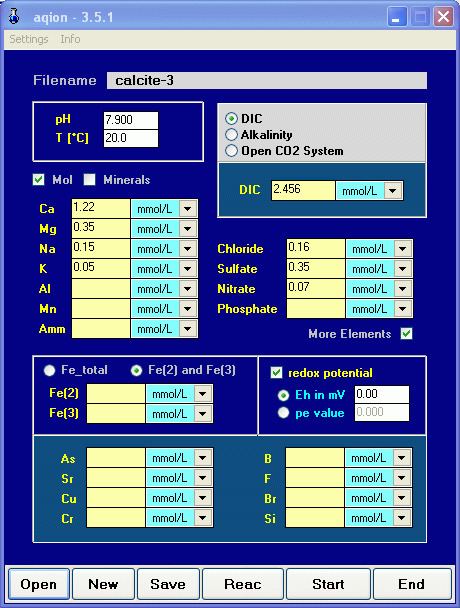Stable release version 6.1 / Feb 2017 Operating system Available in English, German | Written in C++ Size 1.5 MB | |
 | ||
Initial release January 1, 2012 (2012-01-01) | ||
Aqion is a hydrochemistry software tool. It bridges the gap between scientific software (such like PhreeqC) and the calculation/handling of "simple" water-related tasks in daily routine practice. The software aqion is free for private users, education and companies.
Contents
Motivation & history
First. Most of the hydrochemical software is designed for experts and scientists. In order to flatten the steep learning curve aqion provides an introduction to fundamental water-related topics in form of a "chemical pocket calculator".
Second. The program mediates between two terminological concepts: The calculations are performed in the "scientific realm" of thermodynamics (activities, speciation, log K values, ionic strength, etc.). Then, the output is translated into the "language" of common use: molar and mass concentrations, alkalinity, buffer capacities, water hardness, conductivity and others.
History. Version 1.0 was released in January 2012 (after a half-year test run in 2011). The project is active with 1-2 updates per month.
Features
Fields of application
Limits of application
Basic algorithm & numerical solver
There are two fundamental approaches in hydrochemistry: Law of mass action (LMA) and Gibbs energy minimization (GEM). The program aqion belongs to the category LMA approach. In a nutshell: A system of NB independent basis components j (i.e. primary species), that combines to form NS secondary species i, is represented by a set of mass-action and mass-balance equations:
(1) mass action law:
(2) mass balance law:
where Ki is the equilibrium constant of formation of the secondary species i, and νi,j represents the stoichiometric coefficient of basis species j in secondary species i (the values of νj,i can be positive or negative). Here, activities ai are symbolized by curly brackets {i} while concentrations ci by rectangular brackets [i]. Both quantities are related by the
(3) activity correction:
with γi as the activity coefficient calculated by the Debye–Hückel equation and/or Davies equation. Inserting Eq.(1) into Eq.(2) yields a nonlinear polynomial function fj for the j-th basis species:
(4)
which is the objective function of the Newton–Raphson method.
To solve Eq.(4) aqion adopts the numerical solver from the open-source software PhreeqC. The equilibrium constants Ki are taken from the thermodynamic database wateq4f.
Examples, test & verification
The software aqion is shipped with a set of example solutions (input waters) and a tutorial how to attack typical water-related problems (online-manual with about 40 examples). More examples and exercises for testing and re-run can be found in classical textbooks of hydrochemistry.
The program was verified by benchmark tests of specific industry standards.
